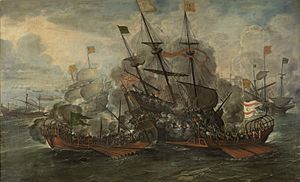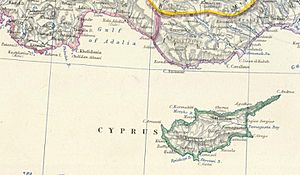Battle of Cape Celidonia facts for kids
Quick facts for kids Battle of Cape Celidonia |
|||||||
|---|---|---|---|---|---|---|---|
| Part of Ottoman-Habsburg wars | |||||||
 Spanish galleons fighting off Ottoman galleys. Oil on canvas by Juan de la Corte (1597–1660), Naval Museum of Madrid. |
|||||||
|
|||||||
| Belligerents | |||||||
| Commanders and leaders | |||||||
| Francisco de Rivera | Bey of Rhodes | ||||||
| Strength | |||||||
| 5 galleons 1 patache 1,600 soldiers |
55 galleys 12,000 soldiers |
||||||
| Casualties and losses | |||||||
| 34 killed 93 wounded |
10 galleys sunk 23 galleys damaged 3,200 killed |
||||||
The Battle of Cape Celidonia was an important sea battle that took place on July 14, 1616. It was part of a long struggle between Spain and the Ottoman Empire for control of the Mediterranean Sea. A small Spanish fleet, led by Francisco de Rivera y Medina, was sailing near Cyprus. They were suddenly attacked by a much larger Ottoman fleet. Even though they were greatly outnumbered, the Spanish ships, mostly large galleons, fought back. They managed to defeat the Ottomans, whose fleet was mainly made up of galleys, causing them heavy losses.
Contents
What Led to the Battle?
In the middle of 1616, a Spanish fleet set sail from the Spanish Kingdom of Sicily. It was commanded by Captain Don Francisco de Rivera y Medina. Their mission was to sail into the Eastern Mediterranean Sea. They aimed to attack Ottoman ships and ports in the area between Cyprus and the region of Çukurova. This type of mission, where ships attack enemy vessels and ports, is called privateering.
Rivera's fleet was quite small. It had 5 large galleons and one smaller ship called a patache. The main ship was the Concepción, which had 52 guns. Other ships included the Almirante, Buenaventura, Carretina, and San Juan Bautista. The small Santiago was the patache. On board these ships were about 1,600 Spanish soldiers. About 1,000 of these soldiers were musketeers, who used muskets (a type of gun).
The Spanish fleet sailed to the island of Cyprus. At that time, Cyprus was ruled by the Ottoman Empire. Near Cyprus, Rivera's fleet captured 16 merchant ships. They also captured an English privateer ship and many smaller boats. In addition, they sank or burned ten warships in the port of Salinas. A landing party from the Spanish fleet also destroyed the port's defenses.
The Ottoman governor of Cyprus quickly learned about the Spanish attacks. He asked the Ottoman navy for help. Rivera found out about the approaching Ottoman relief force. He decided to wait for them near Cape Celidonia. He wanted to win a big victory before returning to Sicily. A few days later, on July 14, a large Turkish fleet appeared. It had 55 galleys, about 275 guns, and 12,000 fighting men.
The Battle Begins
The battle started at 9 in the morning. The Ottoman galleys moved towards the Spanish ships and began firing their guns. The Ottoman fleet had formed a huge crescent shape. They planned to surround the Spanish ships.
The wind was light, which could make it hard for the Spanish ships to stay together. To prevent his ships from being separated and attacked one by one, Rivera gave a clever order. He told his ships to join together end-to-end using chains. The Concepción was at the front. It was followed by the Carretina, the Almiranta, and the patache Santiago. The other two Spanish ships stayed ready to help.
The Spanish ships fired their heavy cannons. This kept the Turkish galleys from getting too close. The fighting continued until sunset. The Ottoman attackers then pulled back to where they started. Eight of their galleys were almost sinking, and many others were damaged.
Day Two of Fighting
The attack started again the next morning. During the night, the Ottomans had held a meeting to plan their next move. They decided to attack in two groups. Each group tried to capture one of the main Spanish ships. One group aimed for the Capitana (Rivera's flagship). The other group aimed for the Almiranta (the secondary ship).
The Ottoman galleys got close enough for the Spanish muskets to fire. But then, the entire Spanish fleet opened fire with their heavy guns. The Ottomans found it impossible to board the Spanish ships. By evening, the Ottoman force pulled back again. Another 10 of their galleys were badly damaged.
The Final Attack
That night, the Turks held another war council. They decided to attack again at dawn. Their leaders gave speeches to boost their spirits. The Ottomans attacked with great determination. They managed to approach Rivera's flagship from a better angle. They hoped to use its "blind spot" (an area where the ship's guns couldn't easily aim).
However, the Spanish commander, Rivera, had thought about this possibility. He ordered the Santiago (the patache) to move to the front of his ship. This move exposed the Turkish galleys to even more heavy gunfire. The Spanish cannons caused severe damage to the Ottoman ships. Finally, the Ottoman force was forced to retreat at 3:00 in the afternoon. Another galley was sunk, two lost their masts, and 17 others were severely damaged.
What Happened Next?
The Turkish fleet suffered very heavy losses. Ten of their galleys were sunk, and another 23 were too damaged to fight. About 1,200 Janissaries (elite Ottoman soldiers) and 2,000 sailors and rowers were killed.
The Spanish had far fewer casualties. They lost 34 men and had 93 wounded. The Concepción and the Santiago had some damage to their rigging (the ropes and masts). They had to be towed by the other Spanish ships.
For his great success, King Philip III promoted Rivera to Admiral. The King also gave him the special honor of joining the Order of Santiago. The soldiers and sailors of the fleet were also recognized by the Duke of Osuna. Some time later, a Spanish writer named Don Luís Vélez de Guevara wrote a play about the battle. It was called "El asombro de Turquía y valiente toledano" (which means "the wonder of Turkey and the courageous Toledoan").
See also
 In Spanish: Batalla del cabo Celidonia para niños
In Spanish: Batalla del cabo Celidonia para niños


